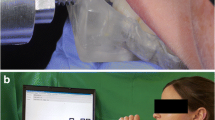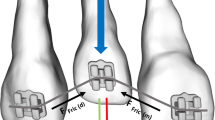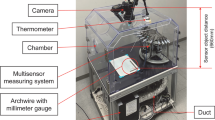Abstract
In order to evaluate interdental forces as a benchmark for mesial drift, a measurement technique was tested and evaluated on a human specimen. The measurement technique is based on the principle that a mesially directed horizontal force (FH) within a complete dental arch has an effect on interdental friction at the points of contact. The dynamic force (Fz), needed to pull out a defined metal strip from the interdental space is equal to the interdental frictional force (FR). Assuming unmodified approximal surfaces and unchanged tooth mobility in a complete dental arch, relative modifications of the interdental frictional force level provide a way of measuring horizontal force fluctuations. The validity of this measurement technique was measured by applying mesially directed forces of 1 to 5 N to the distal surface of the 2nd molar in a human specimen. The frictional forces measured increased in proportion to the distally applied force. The mesially directed force on the 2nd molar was transmitted in the dental arch anteriorly up to the incisor region and resulted in an increase of frictional forces. The reproducibility of this measurement technique was tested by quantitative analysis of potential measurement errors in the human specimen. The effect on interdental force measurement of the speed at which the metal strip is pulled was evaluated in a range of 50 to 500 mm/min. At the maximum pulling speed of 500 mm/min, a maximum scatter of 8% was recorded. Dependency of the dynamic force on direction of pull was measurable only when the metal strip was angled at more than 15o. Experimental tests on the human specimen confirmed that the measurement technique presented here is sufficiently valid and reproducible for clinical long-term studies of interdental forces.
Zusammenfassung
Zur Verlaufskontrolle der interdentalen Kräfte als Maßstab für die Mesialdrift wurde zunächst eine Meßmethodik an einem Humanpräparat erprobt und überprüft. Die Meßmethodik basiert auf dem Prinzip, daß sich eine mesial gerichtete horizontale Kraft (FH) innerhalb einer geschlossenen Zahnreihe auf die interdentale Reibung an den Kontaktpunkten auswirkt. Die Zugkraft (FZ), um einen definierten Metallstreifen aus dem Interdentalraum herauszuziehen, entspricht dabei der interdentalen Reibungskraft (FR). Unter der Voraussetzung von unveränderten Approximalflächen und gleichbleibender Zahn-beweglichkeit in einer geschlossenen Zahnreihe sind relative Änderungen der interdentalen Reibung ein Maß für horizontale Kraftschwankungen. Zur Überprüfung der Validität dieser Meßmethodik wurden in einem Humanpräparat auf die Distalfläche des zweiten Molaren mesial gerichtete Kräfte von 1 bis 5 N appliziert. Die gemessenen Reibungskräfte stiegen proportional zu der distal applizierten Kraft an. Die mesial gerichtete Kraft auf den zweiten Molaren pflanzte sich in der geschlossenen Zahnreihe bis in die Eckzahnregion fort und führte zu einer Erhöhung der Reibungskräfte. Zur Überprüfung der Reproduzierbarkeit dieser Meßmethodik wurden potentielle Meßfehler im Humanpräparat quantitativ analysiert. Der Einfluß der Zuggeschwindigkeit des Metallstreifens auf die interdentale Kraftmessung wurden in einem Untersuchungsbereich von 50 bis 500 mm/min ließ sich eine Streuung von maximal 8% nachweisen. Eine Abhängigkeit der Zugkraft von der Zugrichtung ließ sich erst ab einer Angulation des Metallstreifens von mehr als 15o messen. Die experimentellen Überprüfungen am Humanpräparat bestätigten der vorgestellten Meßmethodik eine ausreichende Validität und Reproduzierbarkeit zur Bestimmung interdentaler Kräfte in einer klinischen Longitudinalstudie.
Similar content being viewed by others
References
Ades AG, Joondeph DR, Little RM, et al. A long-term study of the relationship of 3rd molars to changes in the mandibular dental arch. Am J Orthod Dentofac Orthop 1990;97:323–35.
Bishara S, Andreasen G. Third molars: A review. Am J Orthod 1983;83:131–7.
Björk A, Jensen E, Palling M. Mandibular growth and 3rd molar impaction. Acta Odont Scand 1952;14:231–6.
Fastlich J. Crowding of mandibular incisors. Am J Orthod 1970;58:156–63.
Forsberg CM. Tooth size, spacing and crowding in relation to eruption or impaction of third molars. Am J Orthod 1988;94:57–62.
Kahl B, Gerlach KL, Hilgers RD. A long-term, follow-up, radiographic evaluation of asymptomatic impacted third molars in orthodontically treated patients. Int J Oral Maxillofac Surg 1994;23:279–84.
Kaplan RG. Mandibular third molars and postretention crowding. Am J Orthod 1974;66:411–30.
Lindqvist B, Thilander B. Extraction of third molars in cases of anticipated crowding in the lower arch. Am J Orthod 1982;81:130–9.
Moss JP, Picton DCA. Experimental mesial drift in adult monkeys. Arch Oral Biol 1967;12:1313–30.
Moss JP, Picton DCA. Mesial drift of teeth in adult monkeys when forces from the cheeks and tongue had been eliminated. Arch Oral Biol 1970;15:979–87.
Osborn JW. An investigation into the interdental forces occurring between the teeth of the same arch during clenching the jaws. Arch Oral Biol 1961;5:202–11.
Olive R, Basford K. Reliability and validity of lower third molar space—assessment techniques. Am J Orthod 1981;79:45–53.
Richardson ME. Late lower arch crowding: facial growth or forward drift? Eur J Orthod 1979;1:219–25.
Richardson ME. Late lower arch crowding in relation to primary crowding. Angle Orthod 1982;52:300–12.
Richardson ME. The role of the third molar in the cause of late lower arch crowding. a review. Am J Orthod Dentofac Orthop 1989;95:79–83.
Richardson ME, Mills K. Late lower arch crowding: The effect of second molar extraction. Am J Orthod Dentofac Orthop 1990;98:242–6.
Schwarze CW. Ist die Mesialwanderung der Seitenzähne meßbar? Dtsch Zahnärztl Z 1968;23:1366–9.
Schwarze CW. Hat die Keimentfernung der Weischeitszähne Einfluß auf die Spätform des Zahnbogens? Fortschr Kieferorthop 1973;34:387–400.
Schwarze CW. The influence of third molar germectomy—a comparative long-term study. London: Transactions of the 3rd International Orthodontic Congress, 1975:551–62.
Shanley LS. The influence of mandibular third molars on mandibular anterior teeth. Am J Orthod 1962;48:786–9.
Southard TE, Behrents RG, Tolley EA. The anterior component of occlusal force Part I. Measurement and distribution. Am J Orthod Dentofac Orthop 1990;97:323–35.
Southard TE, Southard KA, Tolley EA. Variation of approximal tooth contact tightness with postural change. J Dent Res 1990;69:1776–9.
Southard TE, Southard KA, Weeda LW. Mesial force from unerupted third molars. Am J Orthod Dentofac Orthop 1991;99:220–5.
Waldron R. Question of the influence of erupting or impacted third molars on the occlusion of treated and untreated cases. Am J Orthod 1937;24:221–35.
Author information
Authors and Affiliations
Rights and permissions
About this article
Cite this article
Fuhrmann, R., Grave, C. & Diedrich, P. In vitro evaluation of a measurement method to analyze the interdental, mesially directed force. J Orofac Orthop/Fortschr Kieferorthop 59, 362–370 (1998). https://doi.org/10.1007/BF01299772
Received:
Accepted:
Issue Date:
DOI: https://doi.org/10.1007/BF01299772




